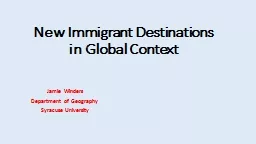

Jamie Winders Department of Geography Syracuse University Ten States with the Largest Latino Populations 2000 Ten States with the Fastest Growth in Latino Population 19902000 From Andrew ID: 262838
Download Presentation The PPT/PDF document "New Immigrant Destinations in Global Con..." is the property of its rightful owner. Permission is granted to download and print the materials on this web site for personal, non-commercial use only, and to display it on your personal computer provided you do not modify the materials and that you retain all copyright notices contained in the materials. By downloading content from our website, you accept the terms of this agreement.
Slide1
New Immigrant Destinations in Global Context
Jamie Winders
Department of Geography
Syracuse UniversitySlide2
Ten States with the Largest Latino Populations, 2000
Ten States with the Fastest Growth in Latino Population, 1990-2000
From Andrew
Wainer
. 2004. The New Latino South and the Challenge to Public Education: Strategies for Educators and Policymakers in Emerging Immigrant Communities. Tomas Rivera Policy Institute. Slide3
2010: 48% of Dalton’s 33,000 residents were Hispanic.
2010: 26% of Mayfield’s 10,349 residents were Hispanic.Slide4
2001 novel set in Latino community in Nashville, TN
Where should the study of new immigrant destinations go?Slide5
New immigrant destinations in global contextSlide6Slide7Slide8
New Immigrant Destinations (NIDs) in Global Context
(1) How NIDs have been defined within and beyond the U.S.
(2) NIDs in various geographic contexts
(3) What attention to NIDs in a global context gets us and requiresSlide9
What constitutes NID?
(1) No clear consensus on definition
Singer’s 2004 typology
Former gateways
Continuous gateways
Post-World War II gateways
Emerging gatewaysRe-emerging gatewaysPre-emerging gateways
Massey and
Capoferro
2008: NID
states
if
100% or greater Hispanic population
growth, 1990 to 2000
Shihadeh and Barranco 2013: NID counties if less than 10% Hispanic in 1990Lichter and Johnson 2009: “high-growth area” if rapid Hispanic population growth in 1990s and less than 10% Hispanic in 1990Slide10
NID characteristics
(1) Speed of settlement, not size of population
(2) Lack of institutional infrastructure
(3) Lack of “established ethnic resources” for immigrants (
Atiles and Bohon
2003)(4) Missing link between immigrants and local pastBut…Impacts?
Cape
Verde’s
Chinese
population grew
five-fold
, mid-1990s to
2003
(Haugen and Carlin 2005
)In mid-western town, Hispanic population grew by 5,000%, 1990 to 2006 (McConnell and Miraftab 2008) In rural Arkansas, local schools grew from 3% Hispanic in 1992 to 50% by 2001 (Erwin 2003) How the history of one immigrant group shapes the present reception of another?Slide11
NIDs in the U.S.
(1) NIDs
within
the U.S.
States, counties, communities(2) Strong focus on American South(3) Rural, urban, and suburban
“
perhaps the most significant trend in U.S. population redistribution over the past quarter century” (Lichter and Johnson 2009, 497) “a social, political, economic, and cultural revolution” (Striffler 2007, 676)
“
a golden opportunity to build our empirical and theoretical understanding of immigrant assimilation”
by
watching it unfold in new
contexts
(Waters and Jimenez 2005, 122)Slide12
NIDs in Europe
(1) NIDs
as
countries
(2) “new,” emerging, immature, or young immigration(3) Missing colonial tiesUkrainian and Moldovan immigrants in Portugal
Latin Americans in Ireland vs. Spain (Marrow 2012)
““one of the most striking demographic developments in recent European history” (Azzolini et al. 2012, 47)
Parallel with NIDs in US and history of racial binarySlide13
NIDs in the “Developing World”
(1) Political shifts, as much as economic opportunities, produce NIDs
Changing geopolitical dynamics (Chinese workers in Israel)
Changing political regimes (Rwandan immigrants in South Africa)
Border tightening elsewhere (Nigerian immigrants in China)(2) Growing trend of South-South migration geographies
Role of contract labor, EPZs, labor recruitment
C.f. US story of NIDs
Different context and structure of receptionSlide14
NIDs in a comparative context?
Helen Marrow’s research in rural North Carolina
Hispanic newcomers arriving in 1990s
Past histories of internal tensions have
indirect impact on immigrantsSome Hispanic newcomers experience upward mobility
Ruth McAreavey’s research in rural Northern IrelandPolish immigrants arriving after 2004Past histories of internal tensions have direct impact on immigrants
Most Polish immigrants experience downward mobilitySlide15
Conclusion
(1) Approaching NIDs in a global context makes new
kinds of questions apparent
Diasporas
Worker experiences(2) How much can the concept of “new immigrant destination” stretch?
(3) A literature focused only on the U.S. potentially misses the bigger picture.
Requires “stretching”
Implications of this stretching?